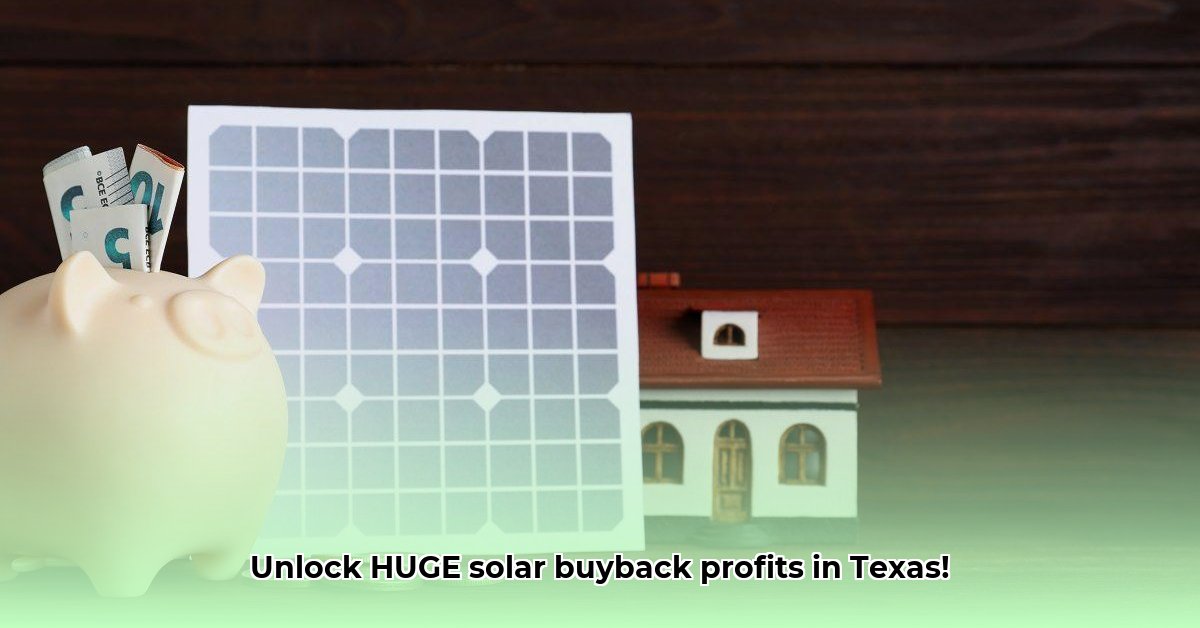Going solar in Texas is a smart move, but understanding the details is crucial! This guide will explain how Texas solar buyback programs work, with a focus on 4Change Energy. We’ll cover the pros, cons, and steps you can take to get the best possible deal. We’ll simplify complex terms and give you the tools to compare companies and choose a plan that maximizes your savings. For more on solar ROI, see this helpful resource. Let’s make sure you get the most from your solar investment!
4Change Energy Solar Buyback: Powering Your Savings in Texas
Thinking about switching to solar energy in Texas? Understanding 4Change Energy’s solar buyback program, along with other available options, is essential for maximizing your return. This guide provides a clear overview of solar buyback programs and how they can benefit homeowners like you.
Cracking the Code: Understanding Texas Solar Buybacks
Texas’s dynamic electricity market means that electric companies offer a variety of solar buyback plans. Instead of receiving a full dollar-for-dollar credit for your excess energy, you’re typically paid a lower rate, similar to a wholesale price. Keep this in mind as you explore your options; 4Change Energy’s buyback program likely operates under this model. Understanding this crucial difference can significantly impact your financial planning.
Key Factors That Affect Your Solar Payback Potential
Several factors will influence your solar buyback earnings:
- Your Energy Consumption Habits: High energy users often see the biggest benefits from solar, even with slightly discounted buyback rates. If your system only generates a small amount of extra energy, the lower rate may translate to smaller overall savings.
- Solar Panel System Size: Larger systems naturally produce more excess energy that can be sold back to the grid, potentially offsetting lower buyback rates. Remember though, larger systems also come with higher initial costs. It’s vital to consult with 4Change Energy for their specific system size guidelines.
- Contract Length: Longer contracts offer the security of predictable payments, but they also lock you in. Shorter contracts provide the flexibility to switch providers if better deals become available. Given the potential for buyback rates to fluctuate, shorter contracts may offer some protection against price drops. Consider what best fits your needs.
Comparing Solar Buyback Plans: A Practical Guide
Direct comparisons between solar companies can feel overwhelming. Here’s a simple, step-by-step approach to help you find the best solution for your home:
- Gather the Facts: Contact 4Change Energy and other solar providers directly to obtain detailed plan information. Pay close attention to import rates (what you pay for energy from the grid) and export rates (what you earn for energy you send back), as well as any hidden fees or specific contract terms.
- Analyze Your Energy Usage: Review your past electricity bills to understand your energy usage patterns throughout the day and across different seasons. This will provide a realistic estimate of how much surplus power your solar system could generate.
- Estimate Your Potential Earnings: Based on your energy consumption and potential solar generation, estimate your earnings from selling excess power back to the grid, taking into account each company’s import and export rates.
- Align with Your Financial Goals: Consider whether you prefer bill credits, direct cash payments, or a combination of both. Your choice will affect how you directly benefit from the solar buyback plan.
- Assess the Risks: Remember that buyback rates are subject to change. Longer contracts provide payment stability, while shorter contracts allow for greater flexibility in case rates shift in your favor.
Understanding Buyback Rates and Local Utilities
The price you receive for your excess solar power can vary based on several factors:
| Factor | Potential Impact |
|---|---|
| Time of Day | You may earn more during peak demand hours, when the grid requires more power. Check with 4Change for their specific peak demand periods. |
| Season | Buyback rates may fluctuate depending on the season and overall energy demand. |
| Export Amount | Some providers offer a lower buyback rate if you exceed a certain threshold of exported power. |
| Plan Specifics | Each buyback plan has its own unique terms and pricing structure. Always read the detailed agreement to understand exactly how it works. |
| Market Conditions | Wholesale electricity prices can fluctuate due to weather, natural gas prices, and other factors, which may influence variable buyback rates. |
Making Informed Decisions: Understanding Deregulation
This guide provides a foundational understanding of how 4Change Energy solar buybacks operate in Texas. However, you should always contact 4Change Energy or other providers directly for the most current rates and program details. Careful planning and thorough research will put you in the best position to maximize your solar power investment. Compare all available options and choose the plan that aligns with your household’s electricity needs and financial objectives.
Comparing Texas Residential Solar Buyback Plans Based on Household Energy Consumption
Key Takeaways:
- The residential solar buyback market in Texas is a multifaceted landscape. A comprehensive understanding is crucial for maximizing your financial gains from distributed generation.
- Buyback plans exhibit considerable diversity in their structures and financial implications. The choice between fixed and variable rates introduces varying degrees of risk and potential reward.
- Your household’s energy consumption patterns exert a direct influence on the profitability of your solar investment. A larger system may not always be the optimal solution.
- A meticulous review of contract terms, encompassing both the contract length and any limitations imposed on net energy exports, is paramount.
- Staying abreast of market trends and regulatory and legislative changes is indispensable for sustained success in the evolving renewable energy sector.
Understanding Your Energy Consumption Patterns
Before diving into specific plans, it’s essential to understand your energy needs. How much energy does your household typically consume? Examine your historical electricity bills to determine your average monthly consumption in kilowatt-hours (kWh). This serves as your baseline. Remember, a larger solar system only becomes financially viable if you consistently use a significant amount of electricity. This step is fundamental in how to compare Texas residential solar buyback plans based on household energy consumption.
Understanding Buyback Plans: Fixed vs. Variable Rates and Demand Response
Most Texas solar buyback plans operate with either fixed-rate or variable-rate structures. Fixed-rate plans offer a consistent price per kWh for electricity exported to the grid, providing predictable returns but potentially incorporating higher monthly fees or export limitations. Variable-rate plans, often linked to the fluctuating wholesale electricity prices in the ERCOT market, present the opportunity for higher returns but also carry greater risk. Which approach best aligns with your risk tolerance and energy consumption profile?
Analyzing Key Plan Features and Smart Energy Management
Let’s break down the key elements of a Texas solar buyback plan:
- Buyback Rate (Export/kWh): The price you receive for each unit of excess solar energy that you send back to the grid. Fixed rates provide clarity, while variable rates necessitate more in-depth analysis.
- Monthly Fees: Many plans include monthly charges, which can significantly impact your overall profitability. Carefully factor these fees into your cost-benefit analysis.
- Contract Terms: Contracts typically span 12 months, requiring an annual plan review. This necessitates re-evaluating your financial outlook each year. Are you prepared for this level of cyclical fluctuation?
- Net Metering Policies: Texas’s specific net metering policies govern how imported and exported energy are balanced. A thorough grasp of these nuances is essential, as several factors influence your monthly payment.
- Limitations on Net Exports: Certain plans impose restrictions on the amount of excess energy you can export, potentially limiting your earnings if your system consistently generates more energy than you consume.
Comparing Plans Effectively and Optimizing Energy Usage
Here’s a structured approach tailored to your energy usage:
- Gather Data: Compile your average monthly kWh consumption figures from your past electricity bills.
- Identify Potential Providers: Conduct thorough research to identify electricity providers in your area that offer solar buyback programs.
- Analyze Plan Details: Obtain comprehensive information on buyback rates, monthly fees, contract terms, and any export limitations.
- Calculate Potential Returns: Estimate your potential savings and earnings for each plan, factoring in your consumption patterns and the potential for net exports. Use a spreadsheet to facilitate a clear comparison of the net financial benefits offered by each plan.
- Consider Long-Term Implications: Diligently evaluate the risks associated with variable-rate plans and the financial implications of annual contract renewals.
A Simplified Comparison Table
| Provider | Rate Type | Buyback Rate (¢/kWh) | Monthly Fee ($) | Export Limit (kWh) | Contract Term (Months) |
|---|---|---|---|---|---|
| Provider A | Fixed | 10 | 10 | 1000 | 12 |
| Provider B | Variable | Varies (ERCOT linked) | 5 | Unlimited | 12 |
Disclaimer: This table is for illustrative purposes only. Actual rates and terms may vary. Always consult directly with providers for the most up-to-date information.
[1https://www.texaspowerguide.com/solar-buyback-plans-texas/]
- Hydro Extrusions USA Leads North American Aluminum Profile Solutions - December 28, 2025
- Hydro North America Leads Aluminum Extrusion Solutions Across Diverse Industries - December 27, 2025
- Hydro Extrusion North America Provides Custom Solutions Across Diverse - December 26, 2025
















